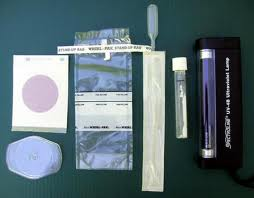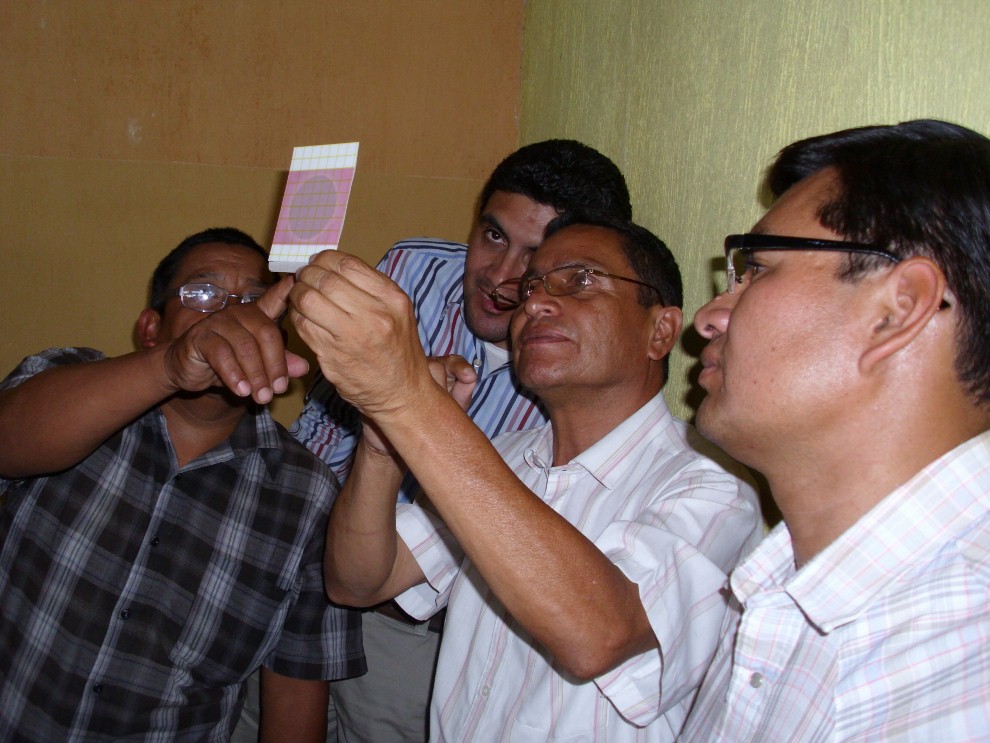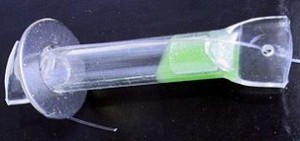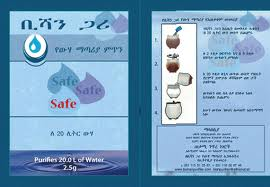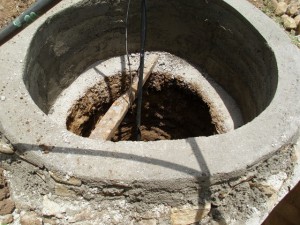Training
A primary activity of IWHA is to train others in the use of the Portable Microbiology Laboratory (PML). Use of the PML allows the user to determine if the bacteria Escherichia Coli is present in water which is an indicator of fecal contamination. Training participants are not required to have any formal education to understand the training concepts or to utilize the two tests for Escherichia Coli contained in the PML.
As part of the training, participants learn to analyze water samples using the IDEXX Colilert test for the presence or absence of Escherichia Coli in a water sample of 10 ml and the 3M Petrifilm which allows a count of Escherichia Coli colonies in a 1 ml sample of water.
Training participants have included personnel of International Development Agencies including the United Nations Food and Agriculture Organization (FAO), UN Habitat, United Nations High Commissioner for Refugees, government institutions including Ministries of Health in several countries and staff and volunteers of volunteer organizations including the Red Cross and volunteer institutions such as NAREWAMA and FOTO in Kenya. Training has been provided to local community organizations including water committees.
IWHA regularly provides demonstrations and individual training in the use of the PML at international events such as the 1st International Water Association (IWA) Development Congress in Mexico City in 2009, the IWA World Water Congress and Exhibition in Montreal in 2010 and the UN Habitat World Water Week in Stockholm, Sweden in 2011.
Testing
IWHA promotes use of the Portable Microbiology Laboratory (PML) containing two inexpensive, scientifically vetted tests, sufficient for 50 water samples. Also included are sterile collecting bags, pipettes and a battery operated UV light. All materials fit in a gallon size plastic bag and no incubator is required to obtain overnight results.
A Breakthrough in Water Testing for Developing Countries
A simple and effective water testing kit currently available that can be used at the community level in developing countries to test water sources for the potential risk of disease has been developed by Professor Bob Metcalf, California State University, Sacramento for easy use in the field. The Portable Microbiology Laboratory (PML) contains scientifically vetted tests for the fecal indicator bacterium Escherichia coli in water and food – the Colilert® 10 ml presence/absence test (IDEXX, Westbrook, ME) and the E. coli/Coliform Count PetrifilmTM (3M, St. Paul, MN), a quantitative test for 1 ml.
The PML includes 25 each of Colilert and Petrifilm tests that fit inside a gallon-size zip lock plastic bag, Whirl-Paks to collect water samples, sterile plastic pipettes, a spreader and a battery-operated long-wave UV light for the Colilert test. Just add water and incubate. All tests can be incubated at body temperature and the results obtained overnight.
The Colilert and Petrifilm tests are specific for E. coli because they contain a substrate for the beta-glucuronidase enzyme that is produced by E. coli, but not by environmental coliform bacteria. The test results are present after 12-18 hours incubation. Results provide a disease risk assessment of water sources that correlate with the World Health Organization’s Guidelines for Drinking Water Quality:
| Disease Risk Level | E. coli in sample | Colilert MUG+ | # E. coli Colonies on Petrifilm |
|---|---|---|---|
| Low | <1/10 ml | – | 0 |
| Moderate | 1/10 – 1 ml | + | 0 |
| High | <1-10 ml | + | 1-10 |
| Very High | >10 ml | + | >10 |
The PML and safe water community workshops include:
- a teaching component, easily understood by laymen, explains microbiology and the connection of contaminated water with disease.
- testing contaminated water before and after pasteurization, chlorination, bio-sand filtration, or other effective treatment process provides dramatic visual evidence of how to make water safe for drinking.
- how to introduce the PML and safe water into communities.
Use of the Colilert and Petrifilm tests at the community level in developing countries can contribute significantly to a reduction in water-borne disease.
To view photos of the PML tests and applications in Kenya and Tanzania go to:
http://imageevent.com/bobmetcalf/watertestingpasteurizationinafrica
For more information contact Professor Metcalf at: rmetcalf@waterinternational.org or Patrick Widner, Executive Director, International Water and Health Alliances at: patrick@waterinternational.org
Treatment
IWHA supports Safe Water Practices
Heat treatment. While it has been a traditional practice to boil water to make it safe, it is not necessary to heat water to 212 degrees Fahrenheit or 100 degrees Celsius. If water is heated to the pasteurization temperature of 149 °F, microbes associated with water borne diseases including diarrhea, cholera, typhoid, dysentery, roto rovirus, polio virus, hepatitis A, giardia and E-coli will be killed. By heating water to this lower temperature, water is made safe and fuel is saved as is the time required to find it. This is significant as women in many countries spend 4-6 hours three times a week searching for fuel. The potential impact of pasteurization on the environment is also significant as it is estimated that two billion people, or one third of the world’s population still cook over open fires that require natural resources, such as trees.
Few people with whom IWHA works have thermometers to know when water has reached the pasteurization temperature. A simple device called a water pasteurization indicator (WAPI) is distributed by IWHA to let people know when water has been pasteurized and made safe. The WAPI is a sealed plastic tube partially filled with wax formulated to melt at 149 °F. The reusable WAPI is suspended from a cord and placed in water being heated. When the wax melts, it flows to the bottom end of the tube indicating that the water has been pasteurized and made safe to drink. After the WAPI is removed from the hot water, the wax hardens again and the device is ready to use again.
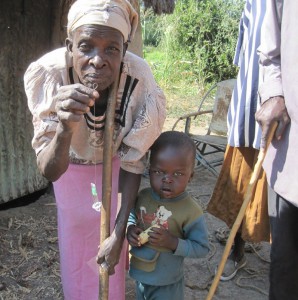
The use of the Water Pasteurization Indicator (WAPI) lets the user know when water has been heated sufficiently to kill dangerous microbes.
Solar cookers made of cardboard and aluminum foil provided by IWHA are an effective, environmentally friendly alternative to open fires that enable solar pasteurization and solar cooking.
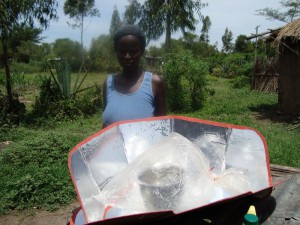
This simple cardboard and aluminum solar cooker can be made locally. In many parts of the world it can cook two meals a day, pasteurize water and eliminate the need to use precious collected wood.
Chemical treatment of water with chlorine based products to kill harmful bacteria and viruses associated with water borne diseases are effective. The cost of these products which are manufactured in liquid or tablet form are added to unsafe water and in most cases, drinking water can be then be used after 30 minutes. The cost of these products depends in part on manufacturing costs and whether or not the product is subsidized.
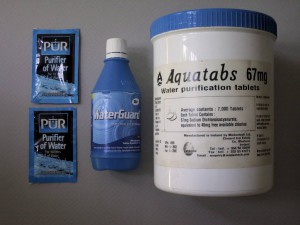
Pur WaterGuard is a subsidized product that costs approximately 25 cents and will treat 1000 liters of water.
Examples below include the
Filters are another option to treat water. Some are more effective and costly than others and need to be serviced regularly to function properly.
Safe storage containers for household use can significantly reduce contamination and the risk of diarrhoeal disease. One of the considerations after treatment of water is to store it safely so that it is not recontaminated. It is IWHA’s belief that sanitation and hygiene should be taught at the same time as water treatment.
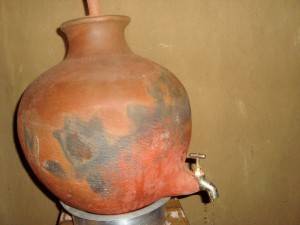
Clay storage containers can be made locally and fitted with a spigot to fill a cup. A small opening at the top allows the container to be refilled but is of such a small size that a child can not reach into the container with a cup or glass to possibly contaminate the clean water.
Water wells can be good sources of safe water when treated, well maintained and then tested regularly for E coli.

